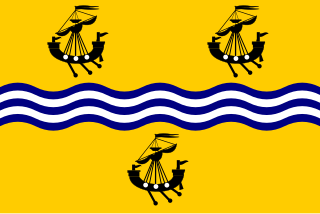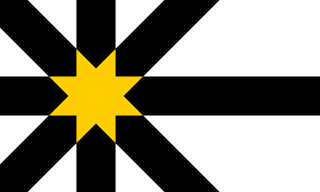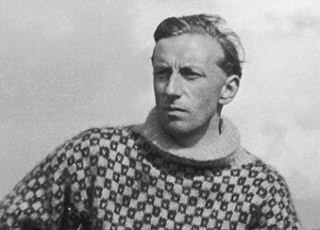John Lister-Kaye | |
|---|---|
| Born | 8 May 1946 |
| Nationality | British |
| Occupations |
|
| Spouses | Lady Sorrel Bentinck (m. 1972;div. 1988)Lucinda, Baroness Burton (after 1989) |
| Children | 4 |
| Parent(s) | Sir John Lister-Kaye, Bt Audrey Helen Carter |
Sir John Philip Lister Lister-Kaye, 8th Baronet, OBE (born 8 May 1946) is an English naturalist, conservationist, author who is owner and director of the Aigas Field Centre, among other business interests. He is married with four children and has lived in the Highlands of Scotland since 1969.
Lister-Kaye was born on 8 May 1946 at Wakefield in Yorkshire and is the son of Sir John Lister-Kaye, 7th Baronet and the former Audrey Helen Carter. His older sister, Mary Eugenia Helen Lister-Kaye, is the wife of Nigel Carrel. [1]
He was born into an ancient established family who for many generations had been Yorkshire landowners, distinguished political figures and successful industrialists with interests in both quarrying and mining. [2] Reportedly, John's early fascination with natural history was something his family hoped he would eventually grow out of. In 1959, at the age of 13, his parents sent him to Allhallows School, near Lyme Regis in Dorset. This was situated within an 800-acre (3.2 km2) national nature reserve and near the wilderness of the Lyme Regis landslip (to which he returned with his daughter, as documented in Nature's Child). After five years in such an environment Lister-Kaye's love of nature was deep and permanent. [2]
After leaving school in 1964, Lister-Kaye worked in the steel industry at Port Talbot in Wales, initially as a management trainee, and continuing until 1969. He has claimed he was persuaded against his wishes to accept the post. [2]
After witnessing the ecological disaster that resulted from the sinking of the supertanker Torrey Canyon [off the Isles of Scilly] in 1967, Lister-Kaye then knew that a long-term career in industry was not for him. [3] In 1968 he was invited by naturalist and author Gavin Maxwell, to move to Maxwell's home on Eilean Bàn (White Island) in the Scottish Highlands, to help him work on a book about British wild mammals and to assist with a project to build a private zoo on the island. [4] Lister-Kaye readily accepted Maxwell's invitation, resigned from his job, and moved to Scotland in 1969. After Maxwell's unexpected death from cancer later that same year, both the book and the zoo project had to be abandoned. [5] Rather than return to a career in industry he remained in Scotland and went into isolation to write a book about the short but eventful time he had spent with Maxwell on Eilean Bàn. His acclaimed first book, The White Island, was published by Longman in 1972. It has remained in print for 30 years.
In 1970, after the completion of The White Island, Lister-Kaye formed Highland Wildlife Enterprises, a natural history guiding service based at the village of Drumnadrochit, near Loch Ness. [6] Initially he was assisted in the venture by friend and ex-employee of Gavin Maxwell, Richard Frere. Two years later this was to become Scotland's first field studies centre, and in 1972, Lister-Kaye and the field centre moved to a remote strath near Glen Affric. [7]
Four years after his marriage, needing to accommodate a growing family and to be able to extend the facilities of the field centre, Lister-Kaye persuaded Inverness-shire County Council to sell him the remains of a Victorian sporting estate near Beauly called Aigas, which had previously been used by the council as an old people's home. [8] In 1977, the Aigas Field Centre was opened by Sir Frank Fraser Darling, Scotland's most celebrated ecologist. [9]
Lister-Kaye was commissioned to write a Penguin Special 'SealCull' (published 1979) on the political row that surrounded a proposal by the UK government to cull thousands of grey seals off the coast of Scotland. The book was adopted by Aberdeen University as a conservation and zoology textbook, cementing Lister-Kaye's reputation as a writer on nature and wildlife and career in the Highlands.
Lister-Kaye's second autobiographical work, The Seeing Eye: Notes of a Highland Naturalist, which was published by Allen Lane in 1979, continues the story of his life from when he left Eilean Bàn in 1970 up until his purchase of Aigas in 1976. In his third, the best-sellingSong of the Rolling Earth: A Highland Odyssey, published in 2003, Lister-Kaye chronicles the place Aigas from the Bronze Age to development of Aigas Field Centre from its humble beginnings to what has become Scotland's premier field centre, winning international awards for environmental education and hosting travel study groups from all over the world. The book's success was to establish Lister-Kaye as one of the UK's foremost nature writers.
A novel One for Sorrow followed in 1994 published by Balnain. It is a real life environmental saga, murder mystery based in the Highlands. In 2003 Lister-Kaye was appointed a Times columnist; as well as contributing features and articles to a wide variety of publications. A subsequent technical paper discussing land use paper for Scottish Natural Heritage, 'Ill Fares the Land' predicted the demise of the Highlands forecasting its current ecological predicament. A foreword by the Prince of Wales did nothing to alleviate his concerns, despite sharing a profound interest in organic sustainability for landscape cultivation.
Lister-Kaye's seventh book is the sequel to Song of the Rolling Earth, 'Nature's Child – Encounters with Wonders of the Natural World' (Time Warner 2004), and is about exciting expeditions and adventures with his youngest daughter Hermione. His eighth is 'At the Water's Edge' published by Canongate in 2010, subtitled 'A Personal Quest for Wildness.'
In 2000, to celebrate the millennium Lister-Kaye took ten members of his family and Aigas Field centre staff on an expedition to follow the footsteps of Laurens van der Post's across the Kalahari Desert (recounted in Nature's Child). In 2008, with his son Warwick and daughter Hermione, Lister-Kaye mounted a private Land Rover expedition up 8,000 miles of Africa's Great Rift Valley from Malawi to Ethiopia to explore and write about the human ecology of the seven countries they passed through. They returned to Scotland in time for the official opening in 2009 of Aigas Field Centre's new environmental education centre by Prince Charles, Duke of Rothesay, and the Duchess of Rothesay.
On 24 June 1972, he was married to Lady Sorrel Deidre Bentinck, a daughter of Henry Bentinck (who later became Earl of Portland). Before they were divorced in 1988, they were the parents of: [1]
He married, secondly, Lucinda Anne (née Law), daughter of Robert Law, on 17 February 1989. Lucinda was previously married to the 4th Baron Burton with whom she had three children. Together, John and Lucinda had one child: [1]
In 1989 Lister-Kaye was appointed to the board of the Nature Conservancy Council, later the Nature Conservancy Council for Scotland (1990) and was appointed the first Regional chairman for the Highlands & Islands of Scotland for Scottish Natural Heritage in 1991. He has also served as Chairman of the Royal Society for the Protection of Birds in Scotland, President of the Scottish Wildlife Trust, the Forestry Commission, and the UK's Environmental Training Agency, and is Vice-President of the Association for the Protection of Rural Scotland.
In 1983 John Lister-Kaye was awarded the Wilderness Society's Gold Award for environmental education for the work of his field studies centre. In 2003 he was appointed OBE for services to the Scottish environment, in 1995 received an honorary doctorate from the University of Stirling and was awarded Honorary Membership of the Scottish Wildlife Trust. In 2006 he received an honorary doctorate from the University of St Andrews, and was made a Vice-President of the RSPB.In 2016 he was awarded the Royal Scottish Geographical Society's Geddes Environment Medal for services to nature conservation and environmental education and made an honorary fellow of RSGS. [10]

The Islands of the Firth of Clyde are the fifth largest of the major Scottish island groups after the Inner and Outer Hebrides, Orkney and Shetland. They are situated in the Firth of Clyde between Ayrshire and Argyll and Bute. There are about forty islands and skerries. Only four are inhabited, and only nine are larger than 40 hectares. The largest and most populous are Arran and Bute. They are served by dedicated ferry routes, as are Great Cumbrae and Holy Island. Unlike the isles in the four larger Scottish archipelagos, none of the isles in this group are connected to one another or to the mainland by bridges.

The Small Isles are a small archipelago of islands in the Inner Hebrides, off the west coast of Scotland. They lie south of Skye and north of Mull and Ardnamurchan – the most westerly point of mainland Scotland.

The Outer Hebrides or Western Isles, sometimes known as the Long Isle or Long Island, is an island chain off the west coast of mainland Scotland. The islands are geographically coextensive with Comhairle nan Eilean Siar, one of the 32 unitary council areas of Scotland. They form part of the archipelago of the Hebrides, separated from the Scottish mainland and from the Inner Hebrides by the waters of the Minch, the Little Minch, and the Sea of the Hebrides.
Lismore is an island of some 2,351 hectares in the Inner Hebrides of Scotland. The climate is damp and mild, with over 166 centimetres (65 in) of rain recorded annually. This fertile, low-lying island was once a major centre of Celtic Christianity, with a 6th-century monastery associated with Saint Moluag, and later became the seat of the medieval Bishop of Argyll. There are numerous ruined structures, including a broch and two 13th-century castles.

Sutherland is a historic county, registration county and lieutenancy area in the Highlands of Scotland. Its county town is Dornoch. Sutherland borders Caithness and Moray Firth to the east, Ross-shire and Cromartyshire to the south and the Atlantic to the north and west. Like its southern neighbour Ross-shire, Sutherland has some of the most dramatic scenery in Europe, especially on its western fringe where the mountains meet the sea. These include high sea cliffs and very old mountains composed of Precambrian and Cambrian rocks.

Rona, sometimes called South Rona to distinguish it from North Rona, is an inhabited island in the Inner Hebrides. It lies between the Sound of Raasay and the Inner Sound just north of the neighbouring island of Raasay and east of the Trotternish peninsula of Skye. It has a total area of 930 hectares (3.6 sq mi) and a population of 3.
Handa Island or simply Handa is an island off the west coast of Sutherland, Scotland. It is 309 hectares and 123 metres (404 ft) at its highest point.

Gavin MaxwellFRSL FZS FRGS was a British naturalist and author, best known for his non-fiction writing and his work with otters. He wrote the book Ring of Bright Water (1960) about how he brought an otter back from Iraq and raised it in Scotland. The otter was of a previously unknown sub-species which was subsequently named after Maxwell. Ring of Bright Water sold more than a million copies and was made into a film starring Bill Travers and Virginia McKenna in 1969.

Loch Shiel is a freshwater loch situated 20 kilometres (12 mi) west of Fort William in the Highland council area of Scotland. At 28 kilometres long it is the 4th longest loch in Scotland, and is the longest to have retained a natural outflow without any regulation of its water level, being 120 m (393 ft) deep. Its nature changes considerably along its length, being deep and enclosed by mountains in the north east and shallow surrounded by bog and rough pasture in the south west, from which end the 4 km River Shiel drains to the sea in Loch Moidart near Castle Tioram.
Priest Island is a small, uninhabited island in the Summer Isles off the west coast of Scotland.

Castle Tioram is a ruined castle that sits on the tidal island Eilean Tioram in Loch Moidart, Lochaber, Highland, Scotland. It is located west of Acharacle, approximately 80 km (50 mi) from Fort William. Though hidden from the sea, the castle controls access to Loch Shiel. It is also known to the locals as "Dorlin Castle". The castle is a scheduled monument.

Eilean Bàn is a six-acre (2.4 ha) island between Kyle of Lochalsh and the Isle of Skye, in the historic county of Ross and Cromarty in the Highland local government area. The Skye Bridge uses the island as a stepping-stone as it crosses the mouth of Loch Alsh from the mainland to Skye.

Aigas Field Centre is a nature centre based at the home of naturalist and author Sir John Lister-Kaye, House of Aigas. The centre was opened in 1977 by ecologist Sir Frank Fraser Darling, and provides nature-based holidays for adults and environmental education services for school children. It is located at Aigas, next to the River Beauly, 8 kilometres (5.0 mi) west of Beauly and 20 kilometres (12 mi) west of Inverness, in the Scottish Highlands.
Lunga is one of the Slate Islands in the Firth of Lorn in Argyll and Bute, Scotland. The "Grey Dog" tidal race, which runs in the sea channel to the south, reaches 8 knots (15 km/h) in full flood. The name "Lunga" is derived from the Old Norse for "isle of the longships', but almost all other place names are Gaelic in origin. The population was never substantial and today the main activity is an adventure centre on the northern headland of Rubha Fiola. The surrounding seas are fished for prawns and scallops and there is a salmon farm off the south eastern shores. The Special Area of Conservation of which the island is part hosts a growing number of outdoor leisure pursuits.

Ornsay is a small tidal island to the east of the Sleat peninsula on the Isle of Skye in the Inner Hebrides of Scotland.

Eilean Munde is a small uninhabited island in Loch Leven, close to Ballachulish.
Eilean Aigas (NH4641) is an island in the River Beauly, Scotland, in Kiltarlity parish in traditional Inverness-shire, now Highland Region. It is most notable for the mansion on it at its north end, which was formerly owned by the Sobieski Stuarts and rented by author and Scottish nationalist Compton Mackenzie from Lord Fraser of Lovat. It is joined to the bank by a narrow white bridge.
Aigas is a small hamlet in the Highland Council area of Scotland. It is 5 miles (8 km) southwest of Beauly and 15 miles (24 km) west of Inverness, on the north bank of the River Beauly. Crask of Aigas is nearby, to the northeast.
Derek Robertson RSW SSA SAA is a Scottish artist. One of the signature members of the Society of Animal Artists, he is known for his paintings of wildlife and landscapes, and for his poetic narrative work consisting of paintings, constructions and installations. He has been elected several times on the Council of the RSW and has written and presented 5 television programs about his work and the wildlife he portrays and has written 5 books about his art: The Mugdrum, Highland Sketchbook, A Studio Under The Sky, Otters, An Artist's Sketchbook, "Living Landscapes" and Puffins: An Artist's Sketchbook. His work has also illustrated many other publications.